Analyzing Employee Motivation: Factors, Strategies, and Unilever
VerifiedAdded on 2023/06/18
|8
|1997
|358
Report
AI Summary
This report delves into the multifaceted nature of employee motivation, emphasizing its critical role in project success and overall organizational goals. It examines various motivation theories, notably Maslow's hierarchy of needs (psychological, safety, love/belonging, self-esteem, and self-actualization) and the distinction between extrinsic (physical rewards) and intrinsic (psychological needs, work environment) motivation. Key motivating factors such as salary, promotion opportunities, and a positive work environment are discussed, alongside potential demotivating factors like employee conflicts and unhygienic conditions. The report concludes by highlighting strategies to mitigate negative factors and foster a motivated workforce, underscoring the importance of a supportive environment where employees can voice opinions and receive recognition for their contributions. The analysis uses Unilever plc as a reference point to illustrate real-world applications of these concepts.
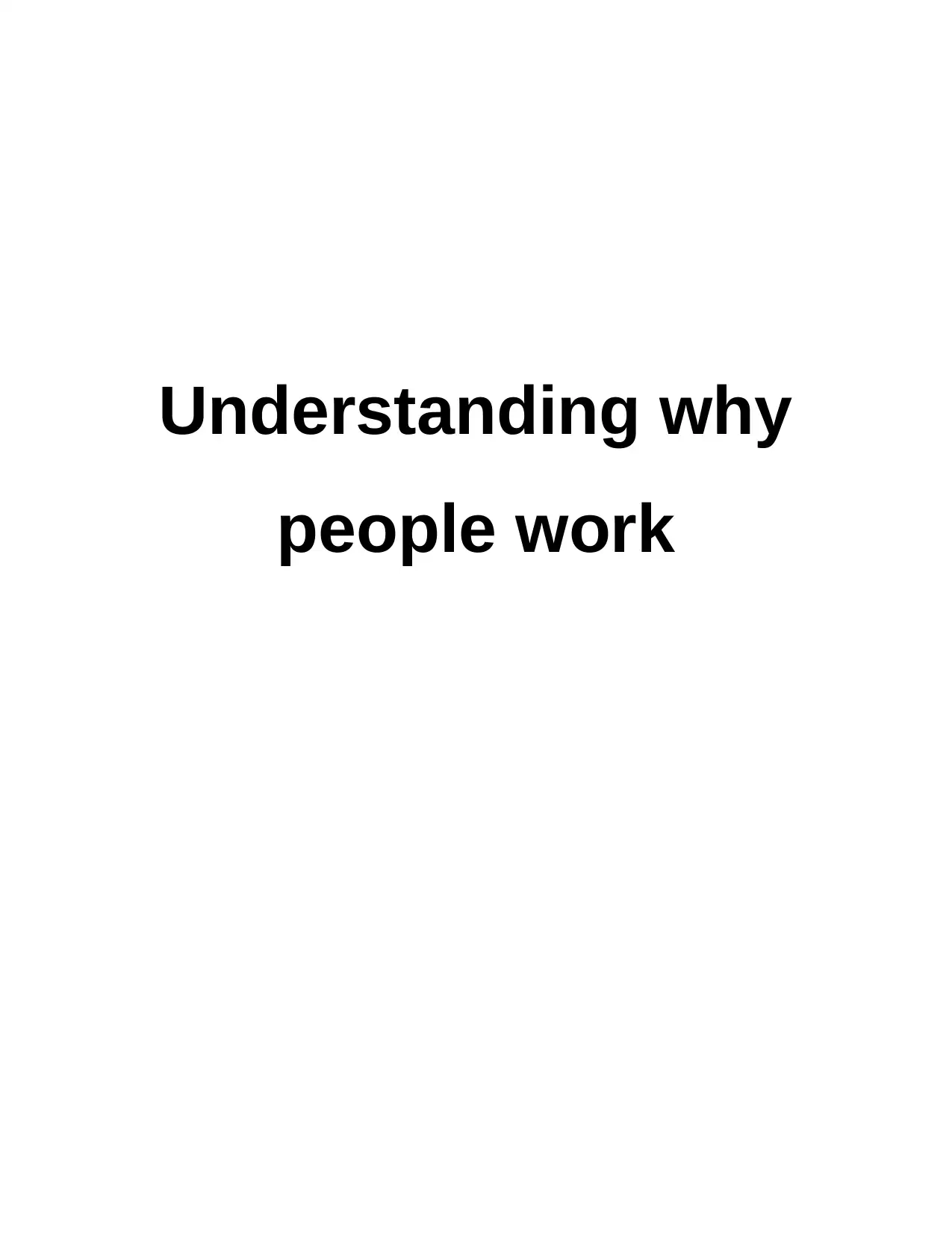
Understanding why
people work
people work
Paraphrase This Document
Need a fresh take? Get an instant paraphrase of this document with our AI Paraphraser
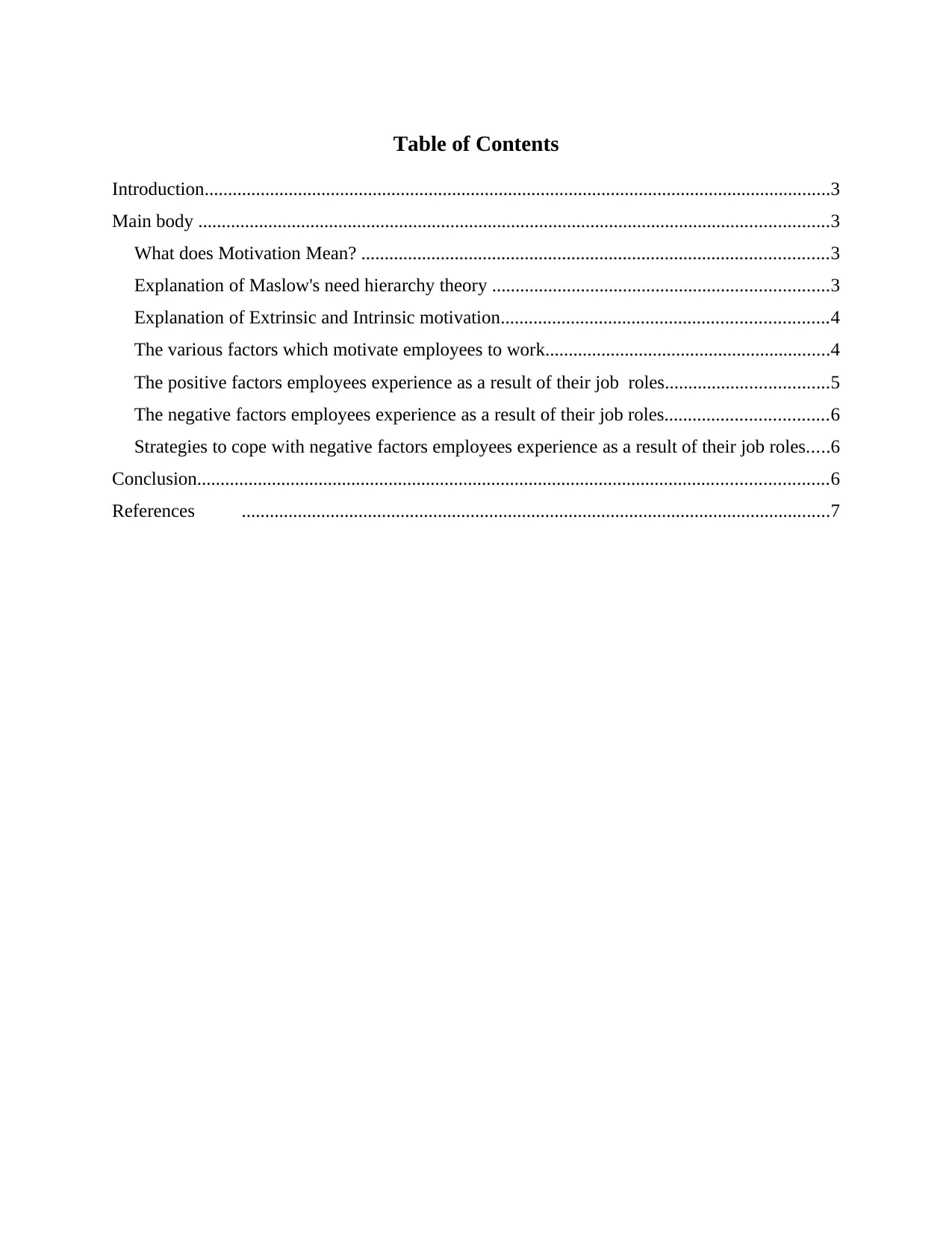
Table of Contents
Introduction......................................................................................................................................3
Main body .......................................................................................................................................3
What does Motivation Mean? ....................................................................................................3
Explanation of Maslow's need hierarchy theory ........................................................................3
Explanation of Extrinsic and Intrinsic motivation......................................................................4
The various factors which motivate employees to work.............................................................4
The positive factors employees experience as a result of their job roles...................................5
The negative factors employees experience as a result of their job roles...................................6
Strategies to cope with negative factors employees experience as a result of their job roles.....6
Conclusion.......................................................................................................................................6
References ..............................................................................................................................7
Introduction......................................................................................................................................3
Main body .......................................................................................................................................3
What does Motivation Mean? ....................................................................................................3
Explanation of Maslow's need hierarchy theory ........................................................................3
Explanation of Extrinsic and Intrinsic motivation......................................................................4
The various factors which motivate employees to work.............................................................4
The positive factors employees experience as a result of their job roles...................................5
The negative factors employees experience as a result of their job roles...................................6
Strategies to cope with negative factors employees experience as a result of their job roles.....6
Conclusion.......................................................................................................................................6
References ..............................................................................................................................7
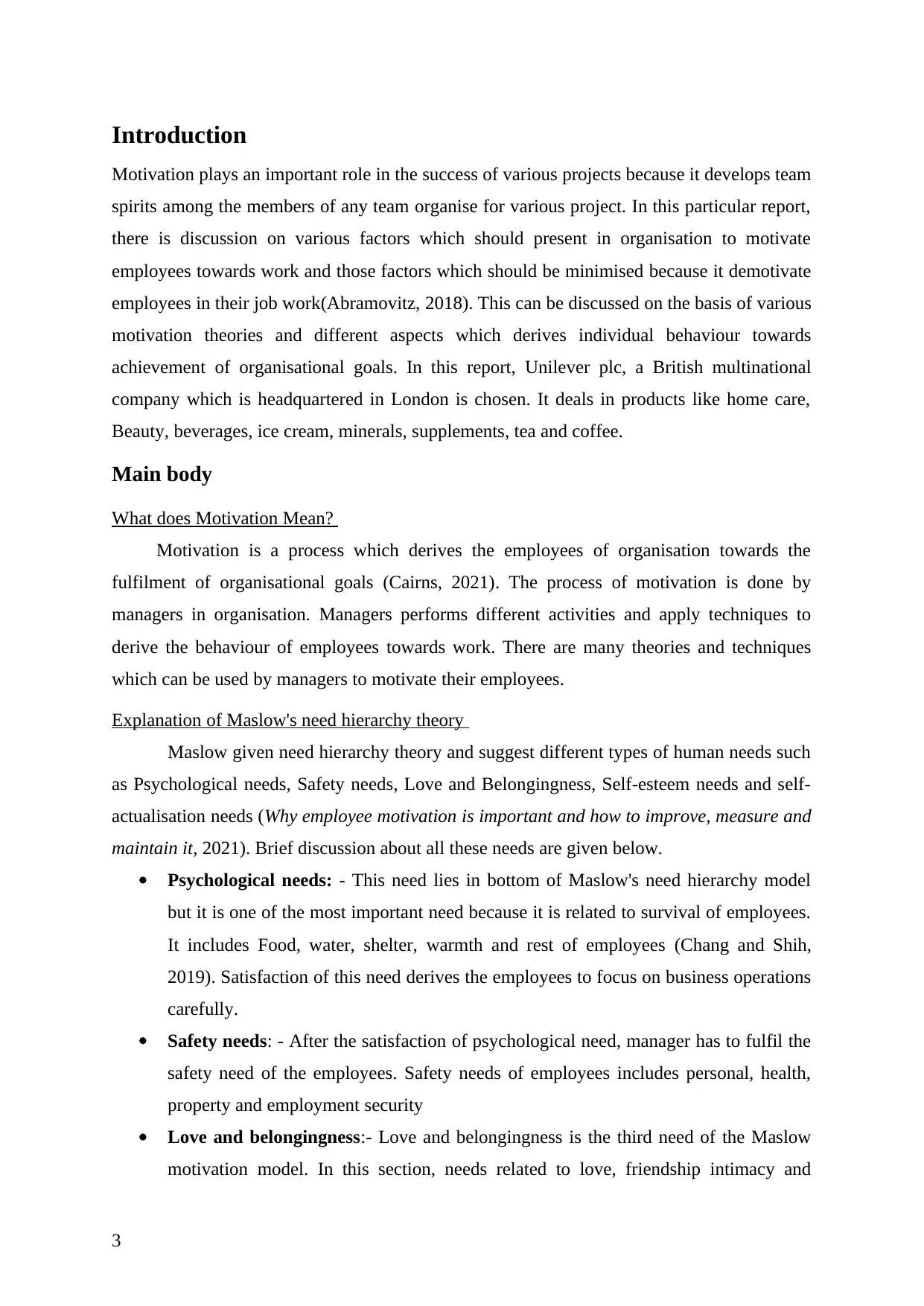
Introduction
Motivation plays an important role in the success of various projects because it develops team
spirits among the members of any team organise for various project. In this particular report,
there is discussion on various factors which should present in organisation to motivate
employees towards work and those factors which should be minimised because it demotivate
employees in their job work(Abramovitz, 2018). This can be discussed on the basis of various
motivation theories and different aspects which derives individual behaviour towards
achievement of organisational goals. In this report, Unilever plc, a British multinational
company which is headquartered in London is chosen. It deals in products like home care,
Beauty, beverages, ice cream, minerals, supplements, tea and coffee.
Main body
What does Motivation Mean?
Motivation is a process which derives the employees of organisation towards the
fulfilment of organisational goals (Cairns, 2021). The process of motivation is done by
managers in organisation. Managers performs different activities and apply techniques to
derive the behaviour of employees towards work. There are many theories and techniques
which can be used by managers to motivate their employees.
Explanation of Maslow's need hierarchy theory
Maslow given need hierarchy theory and suggest different types of human needs such
as Psychological needs, Safety needs, Love and Belongingness, Self-esteem needs and self-
actualisation needs (Why employee motivation is important and how to improve, measure and
maintain it, 2021). Brief discussion about all these needs are given below.
Psychological needs: - This need lies in bottom of Maslow's need hierarchy model
but it is one of the most important need because it is related to survival of employees.
It includes Food, water, shelter, warmth and rest of employees (Chang and Shih,
2019). Satisfaction of this need derives the employees to focus on business operations
carefully.
Safety needs: - After the satisfaction of psychological need, manager has to fulfil the
safety need of the employees. Safety needs of employees includes personal, health,
property and employment security
Love and belongingness:- Love and belongingness is the third need of the Maslow
motivation model. In this section, needs related to love, friendship intimacy and
3
Motivation plays an important role in the success of various projects because it develops team
spirits among the members of any team organise for various project. In this particular report,
there is discussion on various factors which should present in organisation to motivate
employees towards work and those factors which should be minimised because it demotivate
employees in their job work(Abramovitz, 2018). This can be discussed on the basis of various
motivation theories and different aspects which derives individual behaviour towards
achievement of organisational goals. In this report, Unilever plc, a British multinational
company which is headquartered in London is chosen. It deals in products like home care,
Beauty, beverages, ice cream, minerals, supplements, tea and coffee.
Main body
What does Motivation Mean?
Motivation is a process which derives the employees of organisation towards the
fulfilment of organisational goals (Cairns, 2021). The process of motivation is done by
managers in organisation. Managers performs different activities and apply techniques to
derive the behaviour of employees towards work. There are many theories and techniques
which can be used by managers to motivate their employees.
Explanation of Maslow's need hierarchy theory
Maslow given need hierarchy theory and suggest different types of human needs such
as Psychological needs, Safety needs, Love and Belongingness, Self-esteem needs and self-
actualisation needs (Why employee motivation is important and how to improve, measure and
maintain it, 2021). Brief discussion about all these needs are given below.
Psychological needs: - This need lies in bottom of Maslow's need hierarchy model
but it is one of the most important need because it is related to survival of employees.
It includes Food, water, shelter, warmth and rest of employees (Chang and Shih,
2019). Satisfaction of this need derives the employees to focus on business operations
carefully.
Safety needs: - After the satisfaction of psychological need, manager has to fulfil the
safety need of the employees. Safety needs of employees includes personal, health,
property and employment security
Love and belongingness:- Love and belongingness is the third need of the Maslow
motivation model. In this section, needs related to love, friendship intimacy and
3
⊘ This is a preview!⊘
Do you want full access?
Subscribe today to unlock all pages.

Trusted by 1+ million students worldwide
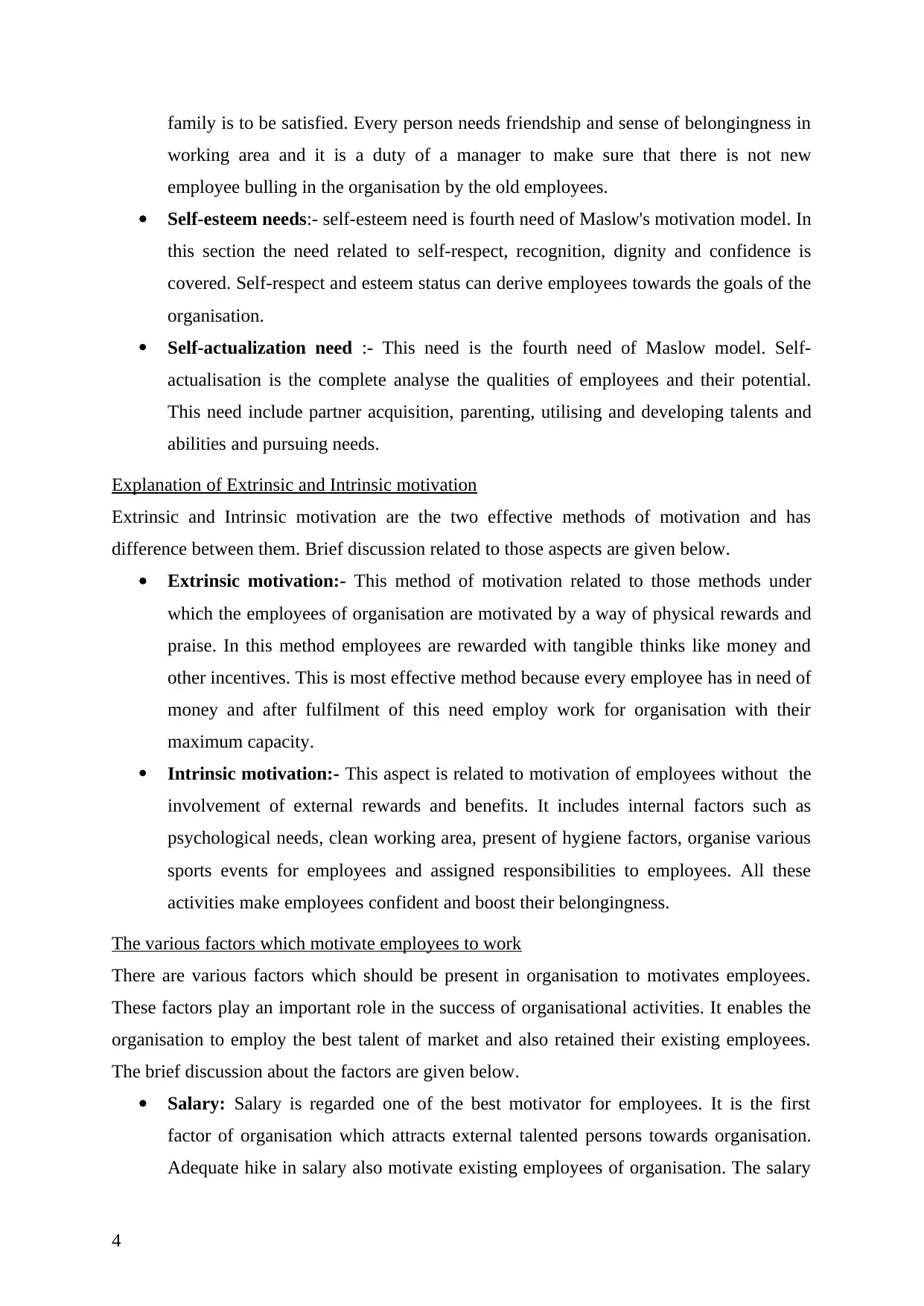
family is to be satisfied. Every person needs friendship and sense of belongingness in
working area and it is a duty of a manager to make sure that there is not new
employee bulling in the organisation by the old employees.
Self-esteem needs:- self-esteem need is fourth need of Maslow's motivation model. In
this section the need related to self-respect, recognition, dignity and confidence is
covered. Self-respect and esteem status can derive employees towards the goals of the
organisation.
Self-actualization need :- This need is the fourth need of Maslow model. Self-
actualisation is the complete analyse the qualities of employees and their potential.
This need include partner acquisition, parenting, utilising and developing talents and
abilities and pursuing needs.
Explanation of Extrinsic and Intrinsic motivation
Extrinsic and Intrinsic motivation are the two effective methods of motivation and has
difference between them. Brief discussion related to those aspects are given below.
Extrinsic motivation:- This method of motivation related to those methods under
which the employees of organisation are motivated by a way of physical rewards and
praise. In this method employees are rewarded with tangible thinks like money and
other incentives. This is most effective method because every employee has in need of
money and after fulfilment of this need employ work for organisation with their
maximum capacity.
Intrinsic motivation:- This aspect is related to motivation of employees without the
involvement of external rewards and benefits. It includes internal factors such as
psychological needs, clean working area, present of hygiene factors, organise various
sports events for employees and assigned responsibilities to employees. All these
activities make employees confident and boost their belongingness.
The various factors which motivate employees to work
There are various factors which should be present in organisation to motivates employees.
These factors play an important role in the success of organisational activities. It enables the
organisation to employ the best talent of market and also retained their existing employees.
The brief discussion about the factors are given below.
Salary: Salary is regarded one of the best motivator for employees. It is the first
factor of organisation which attracts external talented persons towards organisation.
Adequate hike in salary also motivate existing employees of organisation. The salary
4
working area and it is a duty of a manager to make sure that there is not new
employee bulling in the organisation by the old employees.
Self-esteem needs:- self-esteem need is fourth need of Maslow's motivation model. In
this section the need related to self-respect, recognition, dignity and confidence is
covered. Self-respect and esteem status can derive employees towards the goals of the
organisation.
Self-actualization need :- This need is the fourth need of Maslow model. Self-
actualisation is the complete analyse the qualities of employees and their potential.
This need include partner acquisition, parenting, utilising and developing talents and
abilities and pursuing needs.
Explanation of Extrinsic and Intrinsic motivation
Extrinsic and Intrinsic motivation are the two effective methods of motivation and has
difference between them. Brief discussion related to those aspects are given below.
Extrinsic motivation:- This method of motivation related to those methods under
which the employees of organisation are motivated by a way of physical rewards and
praise. In this method employees are rewarded with tangible thinks like money and
other incentives. This is most effective method because every employee has in need of
money and after fulfilment of this need employ work for organisation with their
maximum capacity.
Intrinsic motivation:- This aspect is related to motivation of employees without the
involvement of external rewards and benefits. It includes internal factors such as
psychological needs, clean working area, present of hygiene factors, organise various
sports events for employees and assigned responsibilities to employees. All these
activities make employees confident and boost their belongingness.
The various factors which motivate employees to work
There are various factors which should be present in organisation to motivates employees.
These factors play an important role in the success of organisational activities. It enables the
organisation to employ the best talent of market and also retained their existing employees.
The brief discussion about the factors are given below.
Salary: Salary is regarded one of the best motivator for employees. It is the first
factor of organisation which attracts external talented persons towards organisation.
Adequate hike in salary also motivate existing employees of organisation. The salary
4
Paraphrase This Document
Need a fresh take? Get an instant paraphrase of this document with our AI Paraphraser
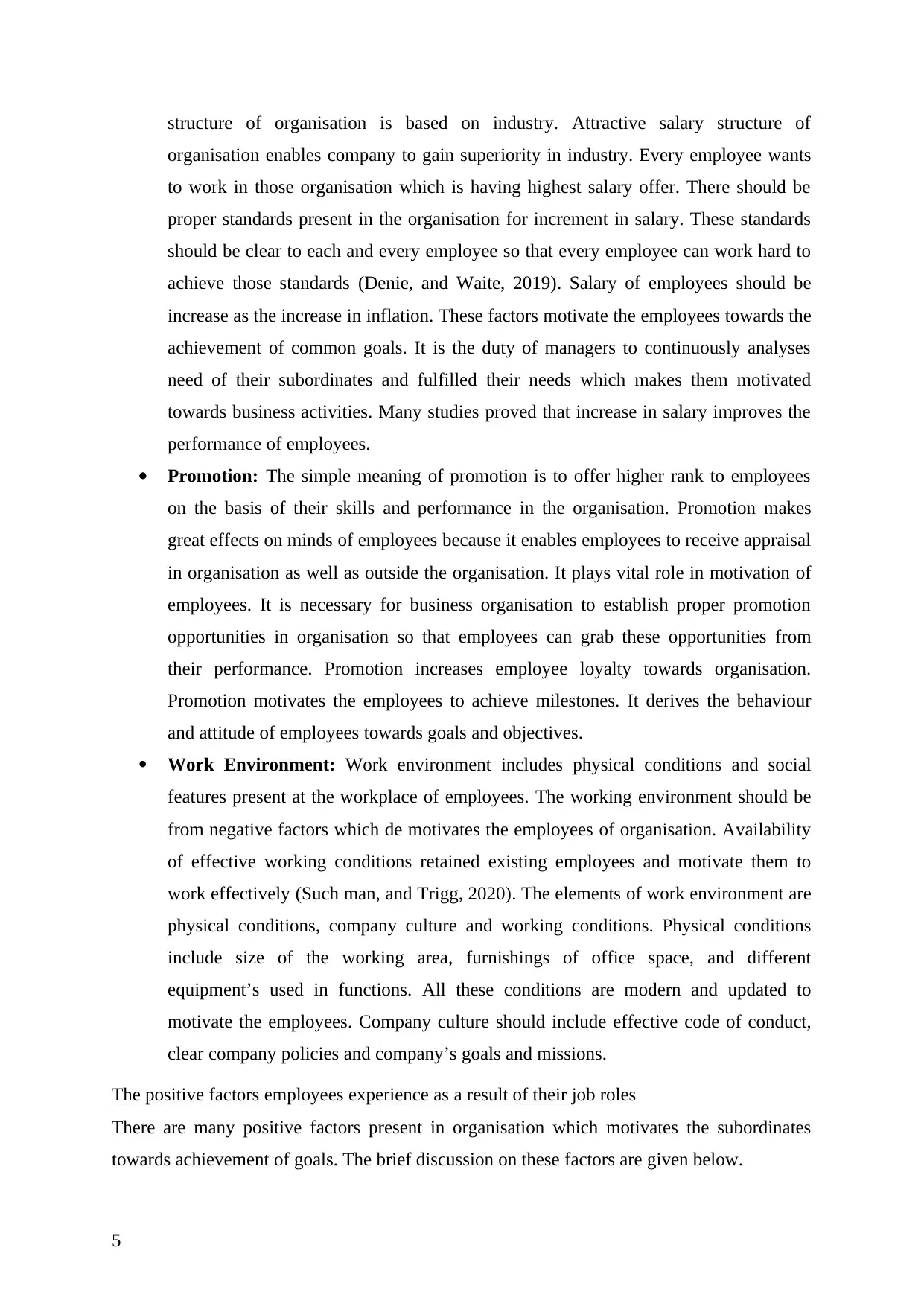
structure of organisation is based on industry. Attractive salary structure of
organisation enables company to gain superiority in industry. Every employee wants
to work in those organisation which is having highest salary offer. There should be
proper standards present in the organisation for increment in salary. These standards
should be clear to each and every employee so that every employee can work hard to
achieve those standards (Denie, and Waite, 2019). Salary of employees should be
increase as the increase in inflation. These factors motivate the employees towards the
achievement of common goals. It is the duty of managers to continuously analyses
need of their subordinates and fulfilled their needs which makes them motivated
towards business activities. Many studies proved that increase in salary improves the
performance of employees.
Promotion: The simple meaning of promotion is to offer higher rank to employees
on the basis of their skills and performance in the organisation. Promotion makes
great effects on minds of employees because it enables employees to receive appraisal
in organisation as well as outside the organisation. It plays vital role in motivation of
employees. It is necessary for business organisation to establish proper promotion
opportunities in organisation so that employees can grab these opportunities from
their performance. Promotion increases employee loyalty towards organisation.
Promotion motivates the employees to achieve milestones. It derives the behaviour
and attitude of employees towards goals and objectives.
Work Environment: Work environment includes physical conditions and social
features present at the workplace of employees. The working environment should be
from negative factors which de motivates the employees of organisation. Availability
of effective working conditions retained existing employees and motivate them to
work effectively (Such man, and Trigg, 2020). The elements of work environment are
physical conditions, company culture and working conditions. Physical conditions
include size of the working area, furnishings of office space, and different
equipment’s used in functions. All these conditions are modern and updated to
motivate the employees. Company culture should include effective code of conduct,
clear company policies and company’s goals and missions.
The positive factors employees experience as a result of their job roles
There are many positive factors present in organisation which motivates the subordinates
towards achievement of goals. The brief discussion on these factors are given below.
5
organisation enables company to gain superiority in industry. Every employee wants
to work in those organisation which is having highest salary offer. There should be
proper standards present in the organisation for increment in salary. These standards
should be clear to each and every employee so that every employee can work hard to
achieve those standards (Denie, and Waite, 2019). Salary of employees should be
increase as the increase in inflation. These factors motivate the employees towards the
achievement of common goals. It is the duty of managers to continuously analyses
need of their subordinates and fulfilled their needs which makes them motivated
towards business activities. Many studies proved that increase in salary improves the
performance of employees.
Promotion: The simple meaning of promotion is to offer higher rank to employees
on the basis of their skills and performance in the organisation. Promotion makes
great effects on minds of employees because it enables employees to receive appraisal
in organisation as well as outside the organisation. It plays vital role in motivation of
employees. It is necessary for business organisation to establish proper promotion
opportunities in organisation so that employees can grab these opportunities from
their performance. Promotion increases employee loyalty towards organisation.
Promotion motivates the employees to achieve milestones. It derives the behaviour
and attitude of employees towards goals and objectives.
Work Environment: Work environment includes physical conditions and social
features present at the workplace of employees. The working environment should be
from negative factors which de motivates the employees of organisation. Availability
of effective working conditions retained existing employees and motivate them to
work effectively (Such man, and Trigg, 2020). The elements of work environment are
physical conditions, company culture and working conditions. Physical conditions
include size of the working area, furnishings of office space, and different
equipment’s used in functions. All these conditions are modern and updated to
motivate the employees. Company culture should include effective code of conduct,
clear company policies and company’s goals and missions.
The positive factors employees experience as a result of their job roles
There are many positive factors present in organisation which motivates the subordinates
towards achievement of goals. The brief discussion on these factors are given below.
5
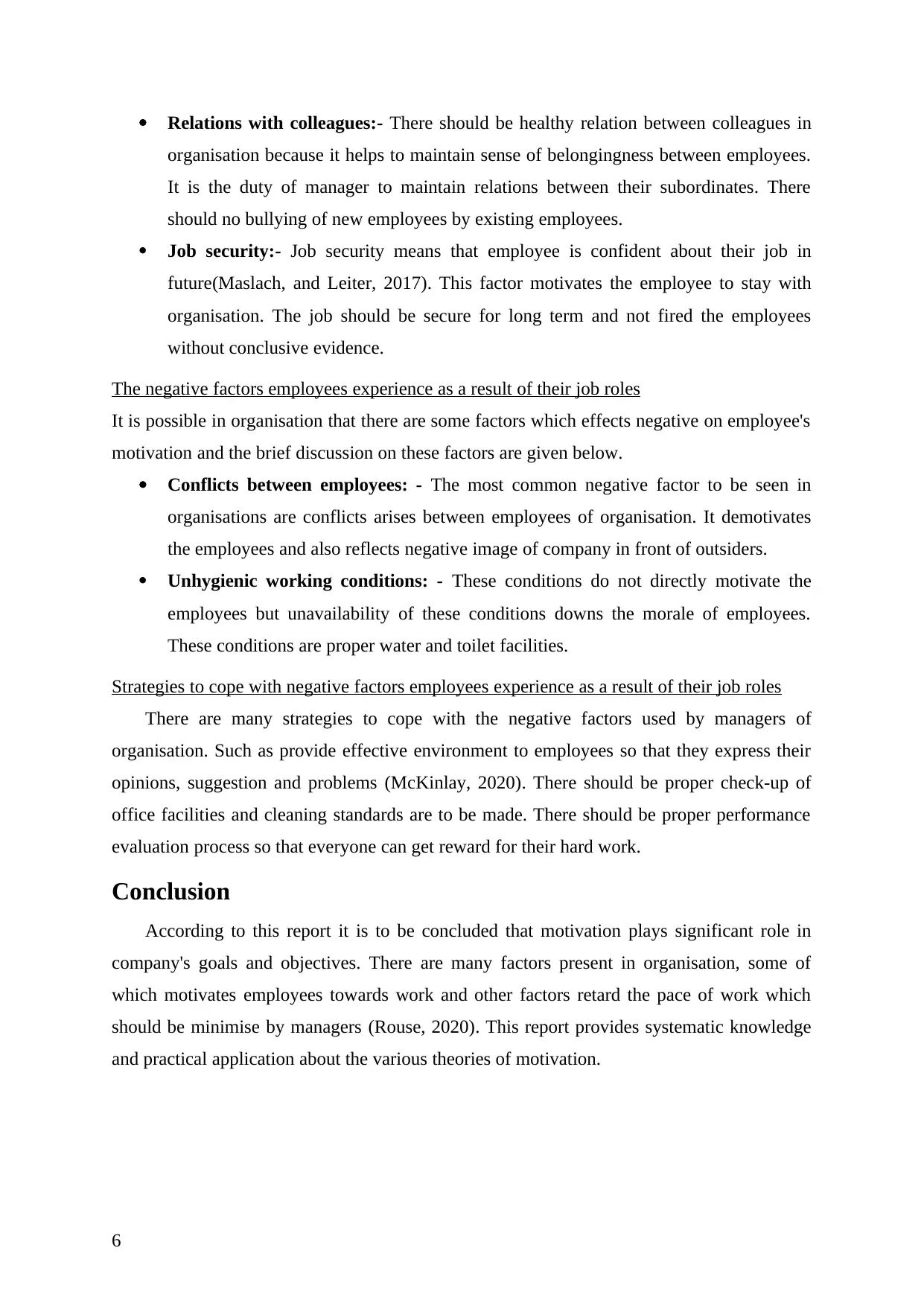
Relations with colleagues:- There should be healthy relation between colleagues in
organisation because it helps to maintain sense of belongingness between employees.
It is the duty of manager to maintain relations between their subordinates. There
should no bullying of new employees by existing employees.
Job security:- Job security means that employee is confident about their job in
future(Maslach, and Leiter, 2017). This factor motivates the employee to stay with
organisation. The job should be secure for long term and not fired the employees
without conclusive evidence.
The negative factors employees experience as a result of their job roles
It is possible in organisation that there are some factors which effects negative on employee's
motivation and the brief discussion on these factors are given below.
Conflicts between employees: - The most common negative factor to be seen in
organisations are conflicts arises between employees of organisation. It demotivates
the employees and also reflects negative image of company in front of outsiders.
Unhygienic working conditions: - These conditions do not directly motivate the
employees but unavailability of these conditions downs the morale of employees.
These conditions are proper water and toilet facilities.
Strategies to cope with negative factors employees experience as a result of their job roles
There are many strategies to cope with the negative factors used by managers of
organisation. Such as provide effective environment to employees so that they express their
opinions, suggestion and problems (McKinlay, 2020). There should be proper check-up of
office facilities and cleaning standards are to be made. There should be proper performance
evaluation process so that everyone can get reward for their hard work.
Conclusion
According to this report it is to be concluded that motivation plays significant role in
company's goals and objectives. There are many factors present in organisation, some of
which motivates employees towards work and other factors retard the pace of work which
should be minimise by managers (Rouse, 2020). This report provides systematic knowledge
and practical application about the various theories of motivation.
6
organisation because it helps to maintain sense of belongingness between employees.
It is the duty of manager to maintain relations between their subordinates. There
should no bullying of new employees by existing employees.
Job security:- Job security means that employee is confident about their job in
future(Maslach, and Leiter, 2017). This factor motivates the employee to stay with
organisation. The job should be secure for long term and not fired the employees
without conclusive evidence.
The negative factors employees experience as a result of their job roles
It is possible in organisation that there are some factors which effects negative on employee's
motivation and the brief discussion on these factors are given below.
Conflicts between employees: - The most common negative factor to be seen in
organisations are conflicts arises between employees of organisation. It demotivates
the employees and also reflects negative image of company in front of outsiders.
Unhygienic working conditions: - These conditions do not directly motivate the
employees but unavailability of these conditions downs the morale of employees.
These conditions are proper water and toilet facilities.
Strategies to cope with negative factors employees experience as a result of their job roles
There are many strategies to cope with the negative factors used by managers of
organisation. Such as provide effective environment to employees so that they express their
opinions, suggestion and problems (McKinlay, 2020). There should be proper check-up of
office facilities and cleaning standards are to be made. There should be proper performance
evaluation process so that everyone can get reward for their hard work.
Conclusion
According to this report it is to be concluded that motivation plays significant role in
company's goals and objectives. There are many factors present in organisation, some of
which motivates employees towards work and other factors retard the pace of work which
should be minimise by managers (Rouse, 2020). This report provides systematic knowledge
and practical application about the various theories of motivation.
6
⊘ This is a preview!⊘
Do you want full access?
Subscribe today to unlock all pages.

Trusted by 1+ million students worldwide
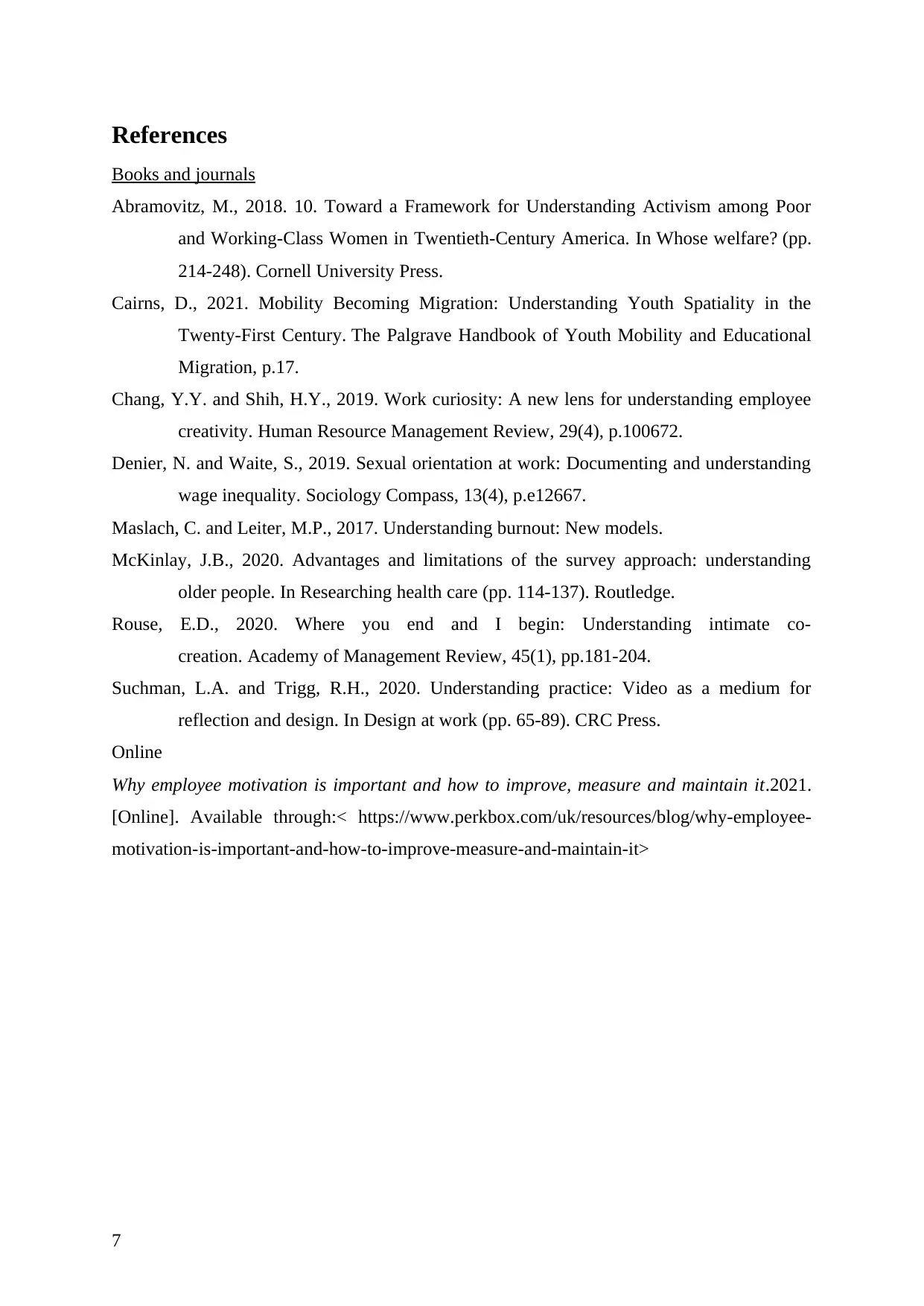
References
Books and journals
Abramovitz, M., 2018. 10. Toward a Framework for Understanding Activism among Poor
and Working-Class Women in Twentieth-Century America. In Whose welfare? (pp.
214-248). Cornell University Press.
Cairns, D., 2021. Mobility Becoming Migration: Understanding Youth Spatiality in the
Twenty-First Century. The Palgrave Handbook of Youth Mobility and Educational
Migration, p.17.
Chang, Y.Y. and Shih, H.Y., 2019. Work curiosity: A new lens for understanding employee
creativity. Human Resource Management Review, 29(4), p.100672.
Denier, N. and Waite, S., 2019. Sexual orientation at work: Documenting and understanding
wage inequality. Sociology Compass, 13(4), p.e12667.
Maslach, C. and Leiter, M.P., 2017. Understanding burnout: New models.
McKinlay, J.B., 2020. Advantages and limitations of the survey approach: understanding
older people. In Researching health care (pp. 114-137). Routledge.
Rouse, E.D., 2020. Where you end and I begin: Understanding intimate co-
creation. Academy of Management Review, 45(1), pp.181-204.
Suchman, L.A. and Trigg, R.H., 2020. Understanding practice: Video as a medium for
reflection and design. In Design at work (pp. 65-89). CRC Press.
Online
Why employee motivation is important and how to improve, measure and maintain it.2021.
[Online]. Available through:< https://www.perkbox.com/uk/resources/blog/why-employee-
motivation-is-important-and-how-to-improve-measure-and-maintain-it>
7
Books and journals
Abramovitz, M., 2018. 10. Toward a Framework for Understanding Activism among Poor
and Working-Class Women in Twentieth-Century America. In Whose welfare? (pp.
214-248). Cornell University Press.
Cairns, D., 2021. Mobility Becoming Migration: Understanding Youth Spatiality in the
Twenty-First Century. The Palgrave Handbook of Youth Mobility and Educational
Migration, p.17.
Chang, Y.Y. and Shih, H.Y., 2019. Work curiosity: A new lens for understanding employee
creativity. Human Resource Management Review, 29(4), p.100672.
Denier, N. and Waite, S., 2019. Sexual orientation at work: Documenting and understanding
wage inequality. Sociology Compass, 13(4), p.e12667.
Maslach, C. and Leiter, M.P., 2017. Understanding burnout: New models.
McKinlay, J.B., 2020. Advantages and limitations of the survey approach: understanding
older people. In Researching health care (pp. 114-137). Routledge.
Rouse, E.D., 2020. Where you end and I begin: Understanding intimate co-
creation. Academy of Management Review, 45(1), pp.181-204.
Suchman, L.A. and Trigg, R.H., 2020. Understanding practice: Video as a medium for
reflection and design. In Design at work (pp. 65-89). CRC Press.
Online
Why employee motivation is important and how to improve, measure and maintain it.2021.
[Online]. Available through:< https://www.perkbox.com/uk/resources/blog/why-employee-
motivation-is-important-and-how-to-improve-measure-and-maintain-it>
7
Paraphrase This Document
Need a fresh take? Get an instant paraphrase of this document with our AI Paraphraser

8
1 out of 8
Related Documents
Your All-in-One AI-Powered Toolkit for Academic Success.
+13062052269
info@desklib.com
Available 24*7 on WhatsApp / Email
![[object Object]](/_next/static/media/star-bottom.7253800d.svg)
Unlock your academic potential
Copyright © 2020–2025 A2Z Services. All Rights Reserved. Developed and managed by ZUCOL.

